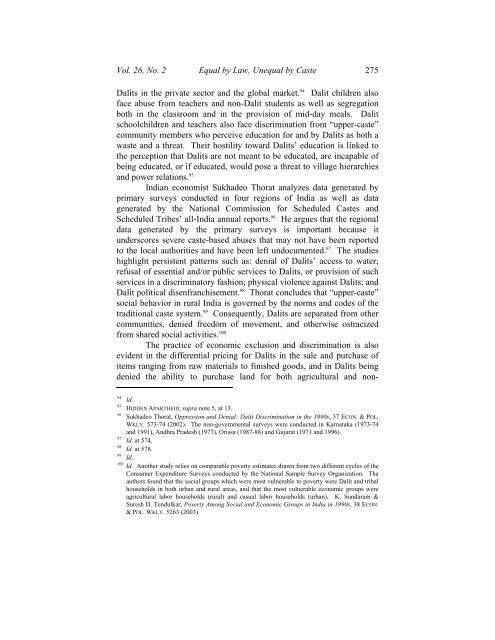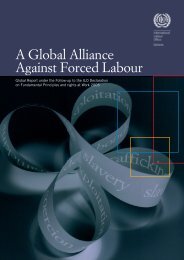274 Wisconsin <strong>International</strong> Law Journalhas no escape from untouchability.” 87 Every village has its ghetto, andthe ghetto is where the <strong>Dalit</strong>s live.“Untouchability” relegates <strong>Dalit</strong>s to a lifetime of discrimination,exploitation, and violence, including severe forms of torture perpetrated<strong>by</strong> state and private actors. 88 Because of the <strong>caste</strong>s into which they areborn, <strong>Dalit</strong>s are forced to work in “polluting” and degrading occupationsand are subject to exploitative labor arrangements such as bonded labor,migratory labor, and forced prostitution. <strong>Dalit</strong> children are vulnerable totrafficking and the worst forms of child labor in these and other areas.<strong>Dalit</strong>s are also discriminated against in hiring and in the payment ofwages <strong>by</strong> private employers. 89Migration and the anonymity of the urban environment have insome cases resulted in upward occupational mobility for <strong>Dalit</strong>s, but themajority continues to perform its traditional or “polluting” functions. Alack of training and education, along with the discrimination faced inseeking other forms of employment, has kept alive these traditions andtheir hereditary nature. A majority of the <strong>Dalit</strong> rural workforce subsistson the menial wages of landless agricultural laborers, earning less thanUS$1 per day. 90 Those in urban areas work mostly in the unorganizedsector. India’s much touted system of reservations or constitutionallyreserved quotas for scheduled <strong>caste</strong>s assists less than 1 percent of the<strong>Dalit</strong> population. In all forms of labor, women are consistently paid lessthan men, compounding the dual discrimination of <strong>caste</strong> and genderdetailed below. 91Segregation between <strong>Dalit</strong>s and non-<strong>Dalit</strong>s is routinely practicedin housing, schools, and access to public and private sector services.Ninety-nine percent of <strong>Dalit</strong> students are enrolled in government schoolsthat lack basic infrastructure, classrooms, teachers, and teaching aids. 92Government schools <strong>by</strong> and large teach in local languages, as opposed toprivate schools—whose students are predominantly “upper-<strong>caste</strong>”—thatteach in English. 93 Their inability to speak English further disadvantages87888990919293AMBEDKAR THOUGHT, supra note 19, at 34.HIDDEN APARTHEID, supra note 5, at 30-32.Id. at 82.BROKEN PEOPLE, supra note 21, at 2.See generally Sukhadeo Thorat et al., Human Poverty and Socially Disadvantaged Groups inIndia, (Human Development Resource Center/United Nations Development Program, IndiaOffice, New Delhi, Jan. 2007).HIDDEN APARTHEID, supra note 5, at 13.Emily Wax, India’s Lower Castes Seek Social Progress in Global Job Market, WASH. POST,Aug. 20, 2007, at A01.
Vol. 26, No. 2 Equal <strong>by</strong> Law, Un<strong>equal</strong> <strong>by</strong> Caste 275<strong>Dalit</strong>s in the private sector and the global market. 94 <strong>Dalit</strong> children alsoface abuse from teachers and non-<strong>Dalit</strong> students as well as segregationboth in the classroom and in the provision of mid-day meals. <strong>Dalit</strong>schoolchildren and teachers also face discrimination from “upper-<strong>caste</strong>”community members who perceive education for and <strong>by</strong> <strong>Dalit</strong>s as both awaste and a threat. Their hostility toward <strong>Dalit</strong>s’ education is linked tothe perception that <strong>Dalit</strong>s are not meant to be educated, are incapable ofbeing educated, or if educated, would pose a threat to village hierarchiesand power relations. 95Indian economist Sukhadeo Thorat analyzes data generated <strong>by</strong>primary surveys conducted in four regions of India as well as datagenerated <strong>by</strong> the National Commission for Scheduled Castes andScheduled Tribes’ all-India annual reports. 96 He argues that the regionaldata generated <strong>by</strong> the primary surveys is important because itunderscores severe <strong>caste</strong>-based abuses that may not have been reportedto the local authorities and have been left undocumented. 97 The studieshighlight persistent patterns such as: denial of <strong>Dalit</strong>s’ access to water;refusal of essential and/or public services to <strong>Dalit</strong>s, or provision of suchservices in a discriminatory fashion; physical violence against <strong>Dalit</strong>s; and<strong>Dalit</strong> political disenfranchisement. 98 Thorat concludes that “upper-<strong>caste</strong>”social behavior in rural India is governed <strong>by</strong> the norms and codes of thetraditional <strong>caste</strong> system. 99 Consequently, <strong>Dalit</strong>s are separated from othercommunities, denied freedom of movement, and otherwise ostracizedfrom shared social activities. 100The practice of economic exclusion and discrimination is alsoevident in the differential pricing for <strong>Dalit</strong>s in the sale and purchase ofitems ranging from raw materials to finished goods, and in <strong>Dalit</strong>s beingdenied the ability to purchase land for both agricultural and non-94Id.95HIDDEN APARTHEID, supra note 5, at 13.96Sukhadeo Thorat, Oppression and Denial: <strong>Dalit</strong> Discrimination in the 1990s, 37 ECON. & POL.WKLY. 573-74 (2002). The non-governmental surveys were conducted in Karnataka (1973-74and 1991), Andhra Pradesh (1977), Orissa (1987-88) and Gujarat (1971 and 1996).97Id. at 574.98Id. at 578.99Id..100 Id. Another study relies on comparable poverty estimates drawn from two different cycles of theConsumer Expenditure Surveys conducted <strong>by</strong> the National Sample Survey Organization. Theauthors found that the social groups which were most vulnerable to poverty were <strong>Dalit</strong> and tribalhouseholds in both urban and rural areas, and that the most vulnerable economic groups wereagricultural labor households (rural) and casual labor households (urban). K. Sundaram &Suresh D. Tendulkar, Poverty Among Social and Economic Groups in India in 1990s, 38 ECON.& POL. WKLY. 5263 (2003).
- Page 1 and 2: EQUAL BY LAW, UNEQUAL BY CASTE: THE
- Page 3 and 4: Vol. 26, No. 2 Equal by Law, Unequa
- Page 5 and 6: Vol. 26, No. 2 Equal by Law, Unequa
- Page 7 and 8: Vol. 26, No. 2 Equal by Law, Unequa
- Page 9 and 10: Vol. 26, No. 2 Equal by Law, Unequa
- Page 11 and 12: Vol. 26, No. 2 Equal by Law, Unequa
- Page 13 and 14: Vol. 26, No. 2 Equal by Law, Unequa
- Page 15 and 16: Vol. 26, No. 2 Equal by Law, Unequa
- Page 17 and 18: Vol. 26, No. 2 Equal by Law, Unequa
- Page 19: Vol. 26, No. 2 Equal by Law, Unequa
- Page 23 and 24: Vol. 26, No. 2 Equal by Law, Unequa
- Page 25 and 26: Vol. 26, No. 2 Equal by Law, Unequa
- Page 27 and 28: Vol. 26, No. 2 Equal by Law, Unequa
- Page 29 and 30: Vol. 26, No. 2 Equal by Law, Unequa
- Page 31 and 32: Vol. 26, No. 2 Equal by Law, Unequa
- Page 33 and 34: Vol. 26, No. 2 Equal by Law, Unequa
- Page 35 and 36: Vol. 26, No. 2 Equal by Law, Unequa
- Page 37 and 38: Vol. 26, No. 2 Equal by Law, Unequa
- Page 39 and 40: Vol. 26, No. 2 Equal by Law, Unequa
- Page 41 and 42: Vol. 26, No. 2 Equal by Law, Unequa
- Page 43 and 44: Vol. 26, No. 2 Equal by Law, Unequa
- Page 45 and 46: Vol. 26, No. 2 Equal by Law, Unequa
- Page 47 and 48: Vol. 26, No. 2 Equal by Law, Unequa
- Page 49 and 50: Vol. 26, No. 2 Equal by Law, Unequa
- Page 51 and 52: Vol. 26, No. 2 Equal by Law, Unequa
- Page 53 and 54: Vol. 26, No. 2 Equal by Law, Unequa
- Page 55: Vol. 26, No. 2 Equal by Law, Unequa
- Page 58 and 59: 312 Wisconsin International Law Jou
- Page 60 and 61: 314 Wisconsin International Law Jou
- Page 62 and 63: 316 Wisconsin International Law Jou
- Page 64 and 65: 318 Wisconsin International Law Jou
- Page 66 and 67: 320 Wisconsin International Law Jou
- Page 68 and 69: 322 Wisconsin International Law Jou
- Page 70 and 71:
324 Wisconsin International Law Jou
- Page 72 and 73:
326 Wisconsin International Law Jou
- Page 74 and 75:
328 Wisconsin International Law Jou
- Page 76 and 77:
330 Wisconsin International Law Jou
- Page 78 and 79:
332 Wisconsin International Law Jou
- Page 80 and 81:
334 Wisconsin International Law Jou
- Page 82 and 83:
336 Wisconsin International Law Jou
- Page 84 and 85:
338 Wisconsin International Law Jou
- Page 86 and 87:
340 Wisconsin International Law Jou
- Page 88 and 89:
342 Wisconsin International Law Jou
















